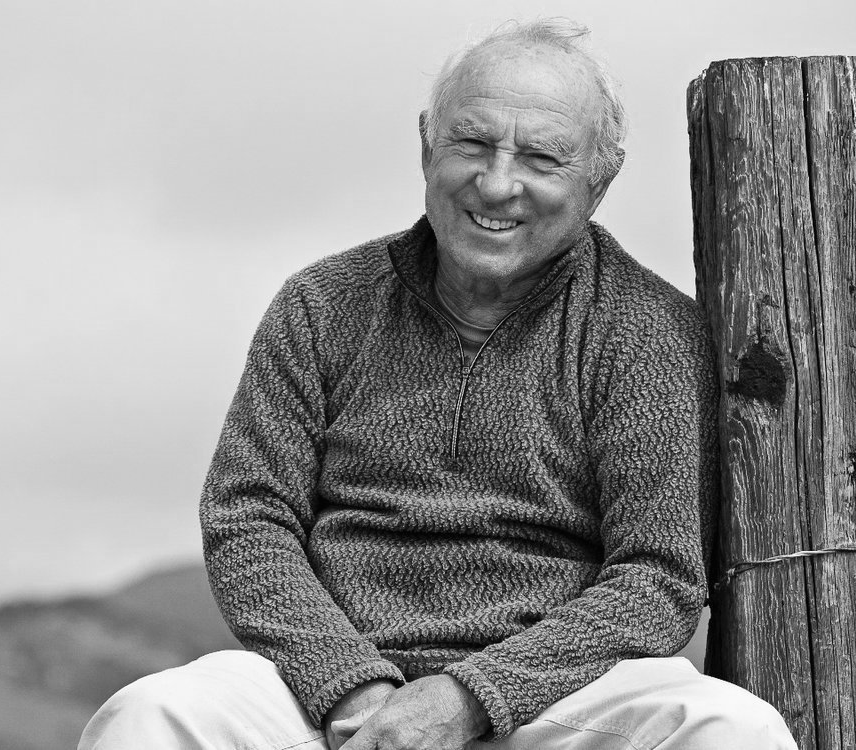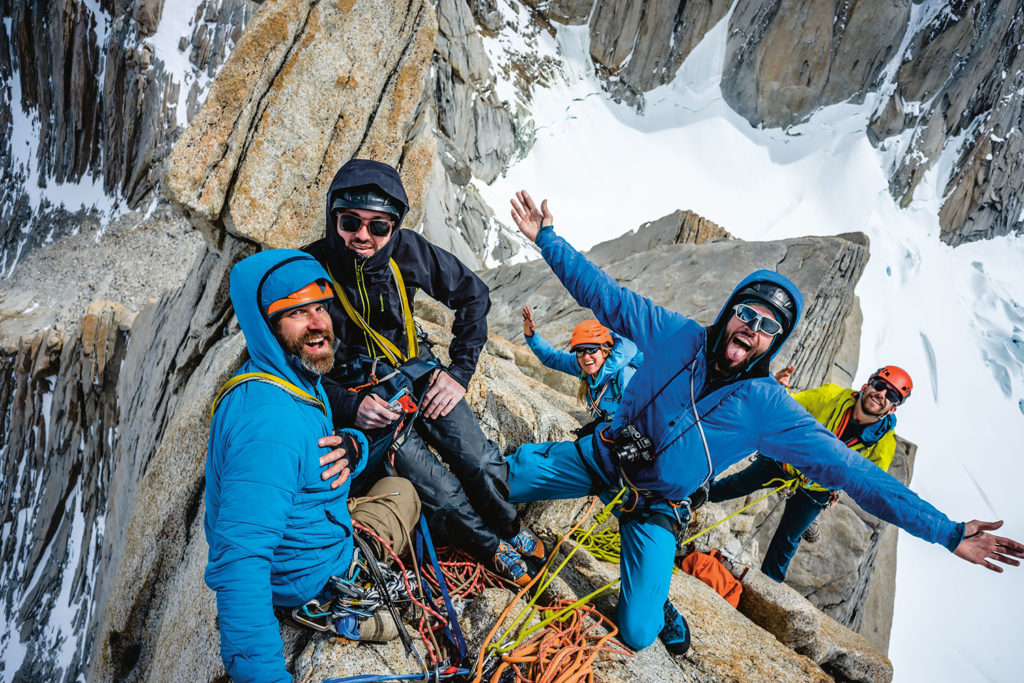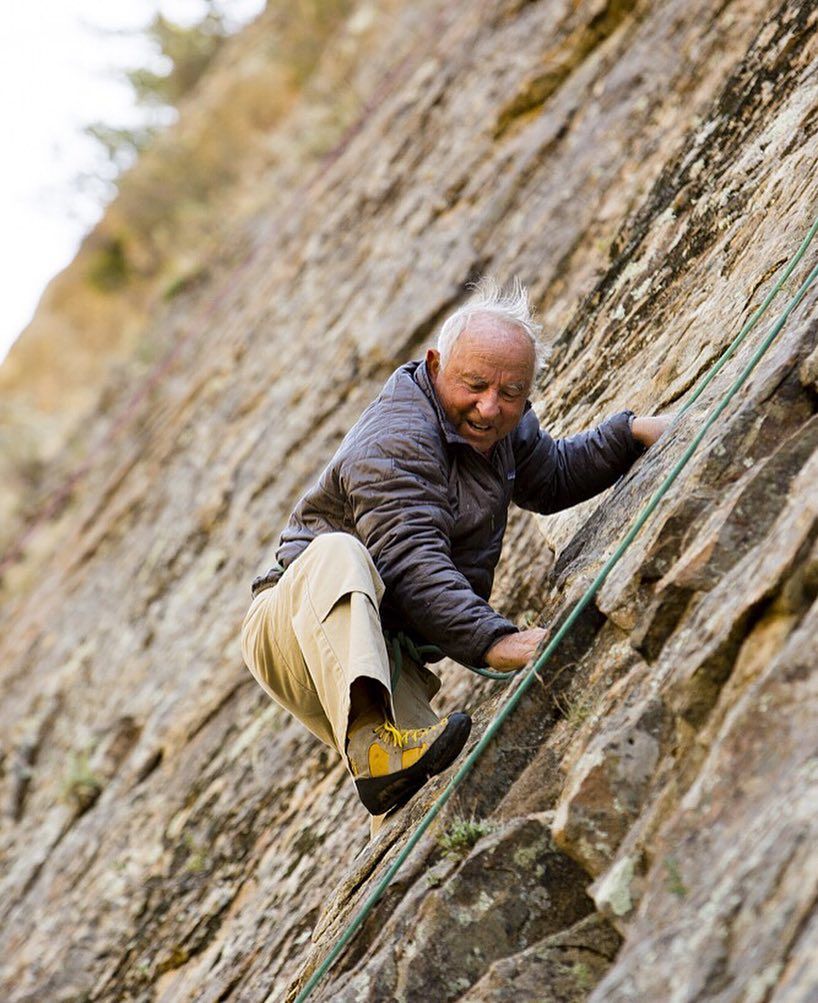
Some food for thought (if you find that you’re hungry for it today) from Yvon Chouinard.
(He pronounces his name yuh-vaan shwee-naard if you’re wondering.)
Throughout, I’ll just call him Yvon, because he seems to invite that kind of familiarity with his plain-speaking forth-rightness.
I’m going to be excerpting some quotes from a recent interview for you to chew on, while adding a few of the associations I made from his storytelling, although I encourage you to listen to what he has to say because you’ll know what I mean about “his plain-speaking and forthrightness” the moment you hear the sound of his voice.
When you see Yvon’s name you might expect French Academy, but when you hear him introducing himself it’s pure Lewiston Maine, which is where he was born from stock that likely wandered down from somewhere around Quebec. That’s why, maybe confounding our expectations, he comes across as a salt-of-the-earth American.
So if you haven’t heard of him or recognize him from his picture, who is this guy anyway?
Yvon’s interview, called “Giving It All Away,” was recorded just before Thanksgiving and I heard it just before I edited and sent out last Sunday’s post. The interview title speaks to the fact that he gave away the entirety of his billion-dollar company earlier this year in an unprecedented act of philanthropy. But perhaps even better, Yvon has been “giving it all away” for most of his life, spending himself in ways that I can only imagine.
So I guess if there’s nutrition to be found in his words, it comes from the arc of his remarkably fertile life and thinking about how we’ve lived and continue to live while he tells us about who he is and what he’s been doing.
Yvon Chouinard is the founder of outdoor clothing and sporting goods company Patagonia. In many people’s minds, the company is almost synonymous with sustainable manufacturing practices and products, protecting wild places (most notably in Patagonia itself, which comprises the southernmost tip of Argentina and Chile), and creating a kind of “hive mind” brand of enlightenment in the company’s workspaces.
Moreover, while striving “to do good,” Patagonia has also consistently ticked off that other big box when it comes to American success stories, namely profitability. Yvon’s company (until recently, solely owned by him, his wife and two kids) will bring in an estimated $1.5 billion in revenues in 2022.
So what does he have to say for himself?

Some outdoorsmen and women that Patagonia corralled into wearing clothing from its “shell” line of sportswear in a recent mail-order catalog. On top of everything else, it’s about looking good and having fun while pushing one’s mental and physical limits.
The interview begins with Yvon’s “changed my life” story. This 81-year-old tells us that he was a “serial climber” early-on, which his poor parents interpreted as something that was pretty grounded until they were watching a local news program in California, where they lived at the time, and the news clip shows (in his words):
a helicopter coming by the North American wall of El Capitan [in Yosemite National Park]. And then it zooms in on these guys hanging from hammocks underneath this big overhang 2000 feet up. And one of ’em is their son. They always thought when I said I was going climbing that I was [just] going hiking.
So boy were they surprised, but he’d already been “a serial climber” for years (which shows, among other things, how little parents know about what their kids are doing) explaining: “I’d spent two years just climbing cracks. I’d spent five years just climbing big walls, like in Yosemite. I’d spent years and years learning ice climbing.” And eventually all that verticality and danger took him to the Himalayas, to a fateful climb that ended in an avalanche, to him somehow surviving while others in his company did not, and to how he felt about the bookends of his existence from that point forward.
[I]t kind of changed my life. I’ve had a lot of close calls, near death experiences, but always afterwards you go around sniffing the flowers and being really happy to be alive and everything…but after that climb, all of us were deeply depressed for several months afterwards, and I’ve read stories about people that have kind of died and come back and you resist coming back. And in fact, it’s taught me that there’s nothing to fear about death itself. It’s a pretty pleasant feeling [when you find yourself face to face with it].
I heard it as a kind of relief, a comfort, once you glimpse that just as much as living, an ending “without fear “also belongs to you.
For the sake of his parents and his own growing family, Yvon cut back on extreme climbs after that, but the experience allowed him to settle into his life in a whole different way. “[Y]ou know, when my time comes, I’m gonna go out pretty peacefully.”
At first, I wondered how he could be so sure about that.
I’d already been reading a new book by Susan Cain, who is most famous for her TED talk and a previous book about introverts. She calls this new one “Bittersweet: How Sorrow and Longing Make Us Whole.” It reminded me of the lengths our culture goes to minimize or hide sorrow, suffering and death even though all of them are universal experiences. So I could understand that when he was taken to a cliff edge by an avalanche at the top of the world, Yvon came to a kind of acceptance that his end was now as much a part of his journey as his moving-on from there, that there was a kind of peace that was waiting for him beyond the physical experience, and that there was a tremendous sense of relief in that deep-seated knowledge.
At this point in the interview, I wondered where I’d found that kind of confidence in the limits of my playing field.
I also marveled at how Yvon described finding his career path. It’s been a preoccupation of mine in several posts (for example, Why We Gravitate Towards the Work That We Do) as well as a theme in my book writing.
I never wanted to be a businessman. I was a craftsman and I was a climber. And I just, every time I’d go into the mountains, I’d have ideas on how to make the gear better. The gear was pretty crude in those days. It was all made in Europe. So I just got myself a forge and an anvil and a book on blacksmithing, and I taught myself how to blacksmith. And that led to making these pitons and eventually ice axes. And crampons and all the gear for mountain climbing and never did it thinking that it was a business. It was at first it was just making the stuff for myself and friends and then friends of friends. And pretty soon I’m making two of these pitons an hour and selling ’em for a dollar and a half each. Well, not too, not too profitable, right? I kind of backdoored becoming a businessman.
I’m sure this sounds more home-spun than it actually was, but meeting his own needs and the needs of his outdoorsy friends was clearly the initial spark. It prompted me to replay my own journey from Perry Mason to courtroom, grade-school Show & Tells to writing in public. (For all of these reasons, if you have a few moments to spare after you finish here, I’d love to hear about the sparks that brought you to the work that you ended up doing too.)
When Patagonia (the company) got to the deliberation phase of its business, it had already begun to lose its way. Demand was growing faster than the company’s capacity to meet it, so Yvon had an extended conversation with his key collaborators about what was most important to them in moving the company to the next level. Those priorities grounded a kind of business philosophy that became Yvon’s 2005 memoir, “Let My People Go Surfing: The Education of a Reluctant Businessman.”
I mean the name of my book is ‘Let My People Go Surfing’ cuz we have a policy. If your child is sick, go home, take care of ’em, uh, no matter what. I don’t care when you work, as long as the job gets done and if the surf comes up, drop everything, go surfing. None of us liked authority. We really disliked authority and none of us wanted to tell other people what to do. So our management system is kind of like an ant colony. You know, an ant colony doesn’t have any bosses. The queen just lays there and lays eggs. There’s no boss in an ant colony but every single ant knows what his job is and gets it done. And they communicate by touching feelers, and that’s about it.
I’d call what he describes here the hive-mind of an enterprise. Unfortunately, I’ve only experienced it once, and never in “the regular course” of any business that I’ve been involved with. The notable exception was a school.
Several years ago I was a teacher in a school for autistic kids, some with significant challenges and all with unbelievable amounts of energy. Only in the inspired chaos of this place, with a teacher-to-kid ratio that approached 1-to-1, did I experience anything like Yvon’s collective working spirit, manifested in the “touching feelers” of my co-workers.
The immediacy and aliveness of every working minute at Benhaven School in New Haven reminded me (years later) of how Rebecca Solnit’s described lower Manhattan’s citizen rescuers coming together after 9/11 and NOLA’s citzen rescuers after Hurricane Katrina, exploits that she chronicles in “Paradise Built in Hell: the Extraordinary Communities That Arise in Disaster.” As I conjured hive-minds like these, and apparently at Patagonia too, I couldn’t help thinking about all of the other places where I’ve worked over the years and how far they’d fallen short of the workers-paradise (at least to me) that Yvon and some remarkable others have helped to create.
Sustainability is another ground-breaking concept for him. It’s about how you make something, but also (his company believes) what you do as a business once one of your products begin to wear out or your customers just get tired of having them around any longer.
For instance, you show your customers how to repair the zipper on, say, your “Reversible Shelled Microdini jacket” or replace the buttons when they‘ve fallen off your “Organic Cotton Mid-Weight Fjord Flannel Shirt.” And when a Patagonia product’s useful life has ended for you, Patagonia even takes it back to try and refurbish it so somebody else can get a second life out of it too, or recycle it into something else if that’s not possible. Because if you pay a lot for quality from a company like this—instead of for one- or two-season throw-away clothes—shouldn’t that item have serial lives too?
Here’s Yvon again, about the lifecycles that Patagonia is enabling for its products:
[Some years ago] we did an ad in the New York Times on Black Friday that said, Don’t buy this jacket, and there’s this photo of this jacket and it said, Don’t buy this jacket without thinking twice. Do you really need it? Are you just bored? Uh, and if so, you know, don’t…[So] If they [our customers], if they made a commitment to think twice about purchasing, we were gonna back it up with our own commitment, which was guaranteeing that jacket for life, repairing it when it needed repair. Helping people find another owner for that jacket. And finally, when it’s absolutely shredded and can’t be used at all, we’ll recycle it into more clothing. And so to do that, we had to build the largest garment repair facility in North America. And we have a van going around to colleges and stuff, showing people how to repair clothes and repairing people’s clothing. We produced a bunch of videos on how to sew a button on so people can repair their own stuff. Cause that’s the best thing you can do is to buy the very best thing you can and try to keep it going as long as possible. And so we’re helping people do that.
When I heard him tell this story I was sorry that I’d recently given my first Patagonia, a full-length rain and wind jacket in a beautiful kind of orange (it had been a really big purchase for me at the time) to a church clothing drive instead of returning it to the company for renewal and transition. Because a circular economy like this is a kind of mind-set, a discipline that can be applied to almost everything if it becomes more engrained in our lives “as consumers”–but I’d never even considered what he’s offering here.
Yvon talks about many other things in this interview (and in his other interviews and writings and speeches over the years) and you might find it edifying to dive into more of his wit & wisdom as a result. But I want to leave you with one of my favorites from last Sunday’s gabfest, where he somehow manages to combine his first career with his current one—which involves lots of interactions with companies that see things differently and governments that almost always do.
How do you convince these people to change the unsustainable and unhealthy ways that they’re doing things when you’re a powerful company like Patagonia or a powerful individual like its founder?
I’ll tell you a little story about mountain guiding. There’s two types of mountain guiding. One is democratic where you, you’re guiding somebody up the Grand Teton, which is a pretty safe mountain. And the client starts freaking out. So you pull out your harmonica and you play your harmonica a little bit. You calm ’em down and you kind of, you know, take your time and, and you get up it, a very effective way to guide on a non-difficult mountain. Let’s say you’re guiding on the Matterhorn and you know, you’re 60 years old, and the guide and you got a family. And you know, you remember the client is always out to kill you. A mountain like that, it’s rotten rock. It’s thunderstorms every afternoon. And the client freaks out. The guide screams at him, pounds on ’em, calls them names, tugs the rope and gets ’em to the top. So what happens is the client is more afraid of the guide than the mountain. And that’s basically how we have to treat our government [and many of our corporations].
I don’t know about you, but I’m a sucker for truth-telling when it’s wrapped up in a musical story like this.
So I hope you’ve enjoyed reading some of his words, that you’ll have a chance to listen to Yvon Chouinard saying them too (because the atmospherics he weaves around them simply can’t be duplicated on the page), and that he’s given you some food for thought to take into the days ahead.

Yvon Chouinard is 81 today, which puts him in his mid-70s when this picture was taken in March 2016, “on a classic local route somewhere out West during a new hire orientation.”
Thanks for reading. Have good week. Signing off today as day-vid gr-icing (since I’m told that some people also find my name unpronounceable).
This post was adapted from my December 4, 2022 newsletter. Newsletters are delivered to subscribers’ in-boxes every Sunday morning, and sometimes I post the content from one of them here. You can subscribe (and not miss any of them) by leaving your email address in the column to the right


